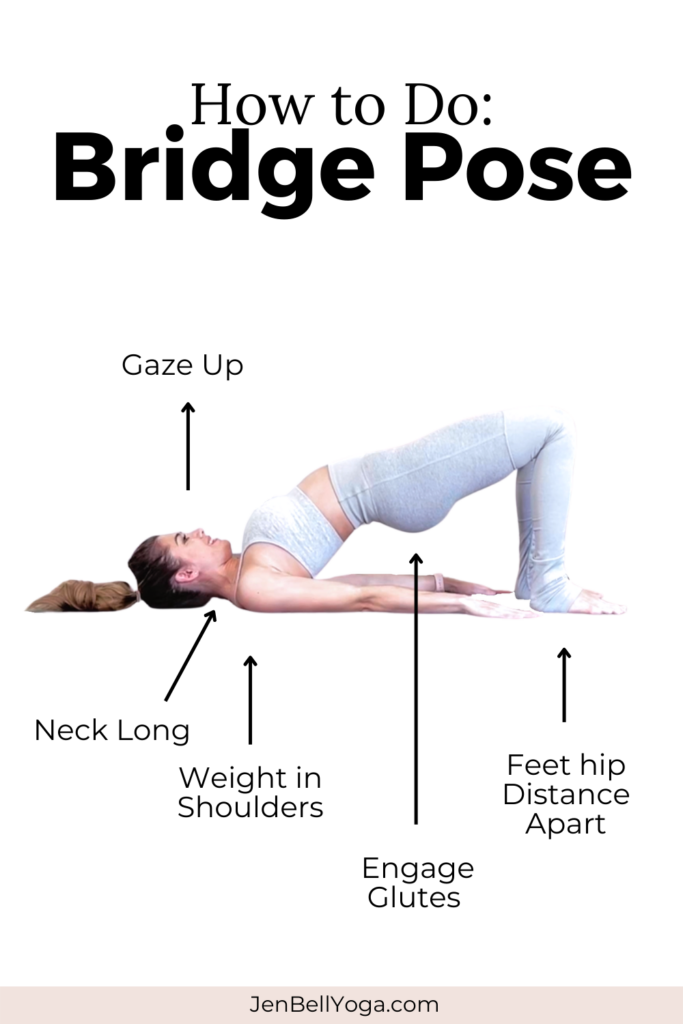
Bridge pose is one of those poses I love to teach! I teach it during my regular yoga classes, other group fitness classes, and with my yoga therapy patients. There are few other poses as versatile as bridge pose. It’s an accessible inversion – your hips are higher than your heart. It can be used to strengthen the muscles of your lower body. It can be used to stretch the hip flexors, back, and neck. It can even be a hands off restorative posture, where you prop yourself up and forget the world around you. You could do the pose in a hospital bed, or you can do the pose on the floor. There are few contraindications to the pose, but typically the pose can be adapted to most situations. It’s not requested often, but no one has ever told me they disliked the posture (let me know if you do dislike bridge pose). It’s no wonder why it’s a fave of mine to teach! You might know the drill by now, but if you don’t, watch and follow along with the video. The same information is written out below along with the “why”s.
** Take a breath ** This blog post DOES contain affiliate links of related products I love and they might even be pictured. If you click on a link and purchase a product (or service) it costs you nothing, you MIGHT even get a discount, and I MAY even receive a SMALL commission. This helps me to buy and drink coffee ☕️ in order to keep me awake and provide you with amazing free content 💗 Thank You for supporting my content 💋
You could theoretically do bridge pose on any horizontal surface, but to keep the neck safe try avoiding surfaces that are too soft. Surfaces that have a large amount of padding or give (think a trampoline) can force the neck into extreme flexion and can be harmful. The type of bridge pose you are doing will make a difference as well. As I mentioned above, you could do bridge pose in a hospital bed, but I would only recommend doing a small supportive/restorative bridge pose where the neck doesn’t go into too much flexion. Maybe by propping the bridge pose up with just a folded blanket, and I would only do this under the guidance of a professional. If you’re healthy (and have had an all clear by your doctor), a yoga mat on the floor will work just fine.
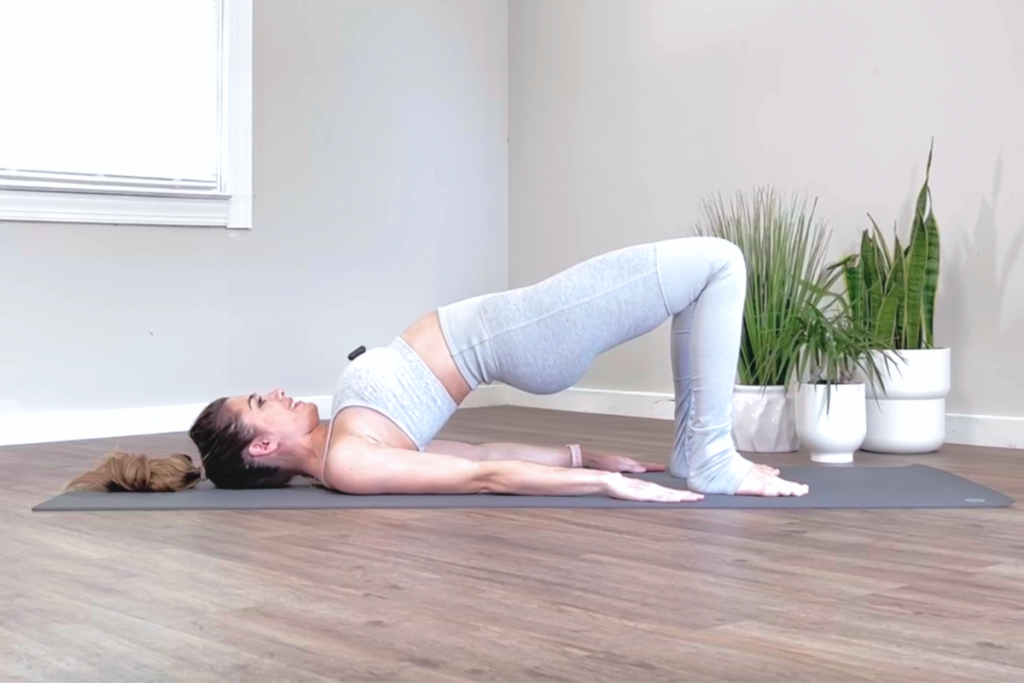
You might have noticed that I didn’t say what part of the breath you should move with in bridge pose. There is no right or wrong way to breathe in bridge pose. In yoga theory you inhale on the expansion (lifting up into bridge), and exhale as you contract (lowering back to the floor). But in exercise physiology you exhale on exertion (lifting into bridge) and inhale on the release (lowering to the floor).
Lifting the hips up and down is very non-specific. You could just lift and lower. Moving in this manor is a little more exercise oriented, and there is nothing wrong with that! You can also articulate the spine one vertebrae at a time, starting from the tail bone and finishing with the thoracic spine (your upper back) as you lift. As you lower, starting with the thoracic and finishing with your tailbone. Depending on your mobility level, you may not even lift that high, and that’s OK too.
The weight in this pose should be equally distributed between your head, shoulders, and feet. One of my favorite things to do is to have myself and my students notice where the weight is in the feet. We’re all aware that we have natural tendencies when we walk to put weight on the insides or outsides of our feet. The same happens in yoga poses. In bridge pose notice where you put the weight. Do you favor the inside? The outside? The toes? Or the heels? Does it change at the bottom or the top of the pose? Maybe it’s different as you move. After noticing, try shifting and changing where you put the weight. How does that feel? Physically? Mentally?
Find out what’s going on… You know you want to… Privacy is important, I won’t sell your info, I promise.
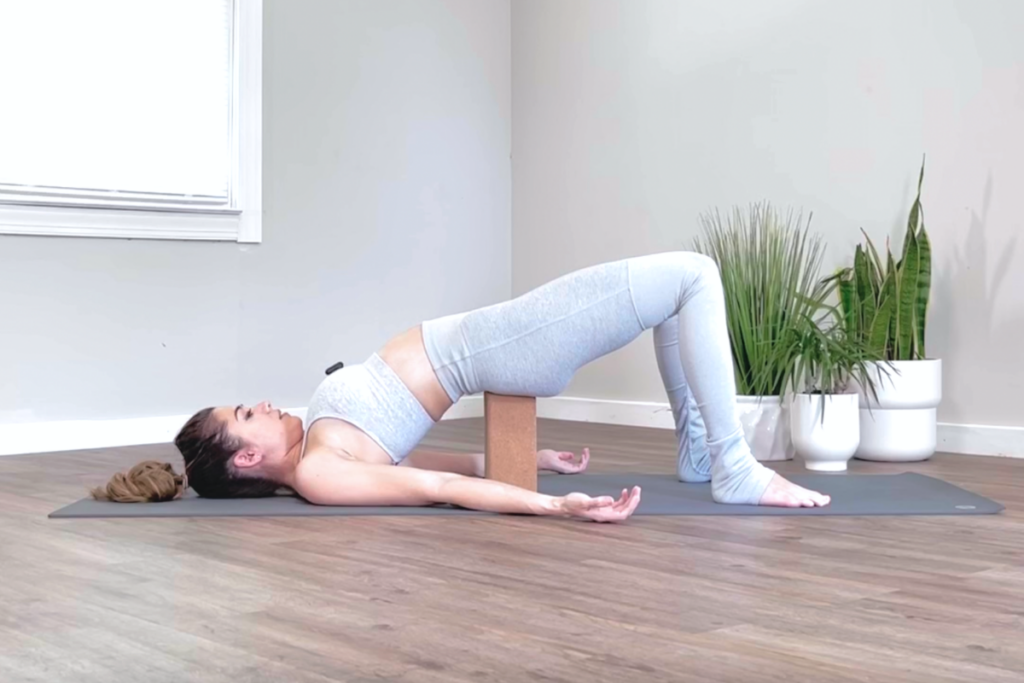
Supported bridge is a nice way to stretch out the front side of the hips. Allowing yourself to relax and feel supported through hip extension can help to release the psoas and other hip flexors that can get tight from sitting, driving, running, cycling and other activities of daily living. There are a variety of ways you can support your bridge pose:
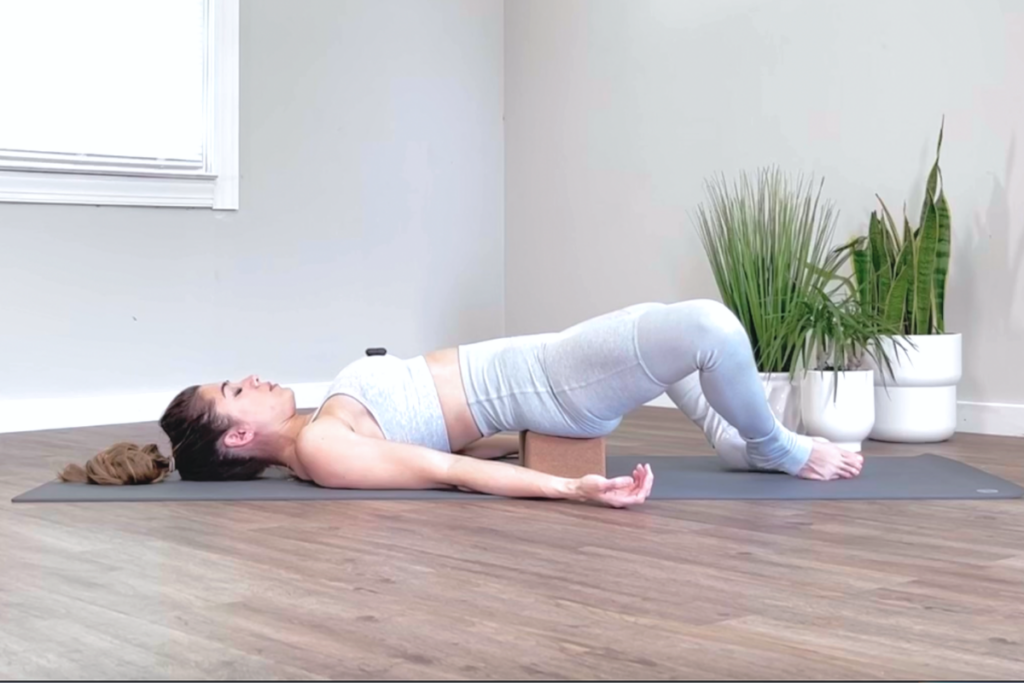
In a supported bridge pose, place the soles of the feet together and let your knees fall apart. You can choose to support the knees as well with blocks or allow them to be just as they are. This allows a stretch through the inner thighs stretching out those adductors.
Bridge pose is mostly a front body stretch. The nice thing about a supported bridge is that you can make sure your lower back is in neutral and that you’re not over exaggerating that lumbar curve. If you need a little help feeling this, try “tucking” your tailbone under (think reach it towards the ceiling), and then support your hips with any of the items listed above for the hip flexor stretch.
This is one of my favorite ways to stretch my neck! Maybe it’s because I’m short, but I find myself looking up so much throughout the day that I love to stretch the back side of my neck at the end of the day. If you suffer from tension headaches this is another great way to stretch out those neck muscles. If you do get tension headaches, check out this post on mindful neck stretching.
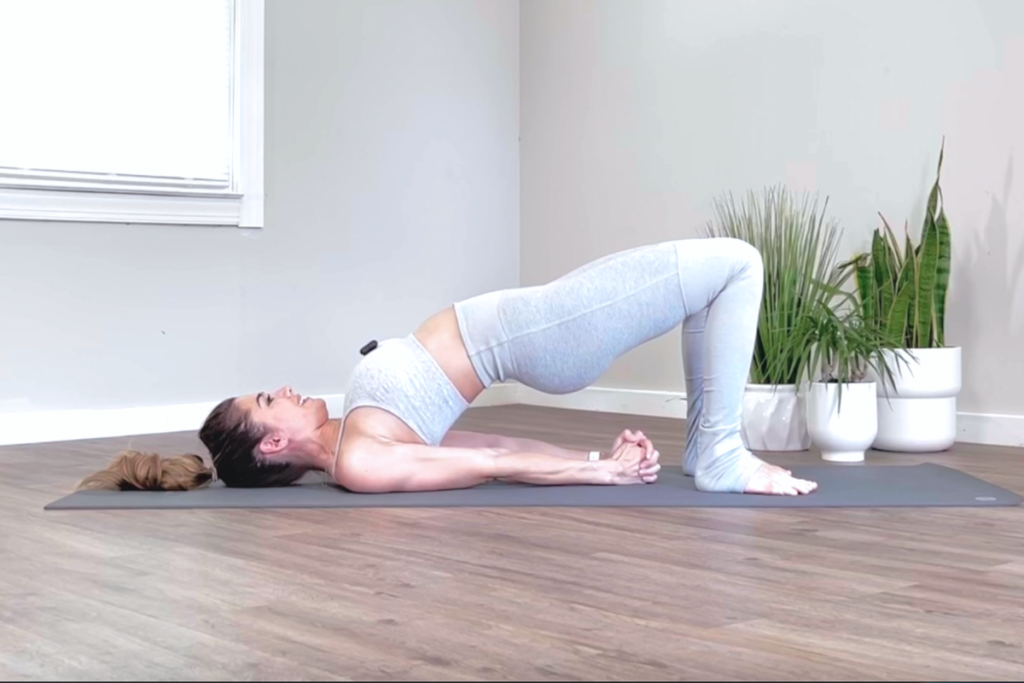
There are so many ways to work your legs and glutes in bridge pose! Let’s break it down by muscle groups:
Your main butt muscles are responsible for the lift into bridge. Any version of bridge pose will get those muscles, but if you want to really feel the work here are some tips:
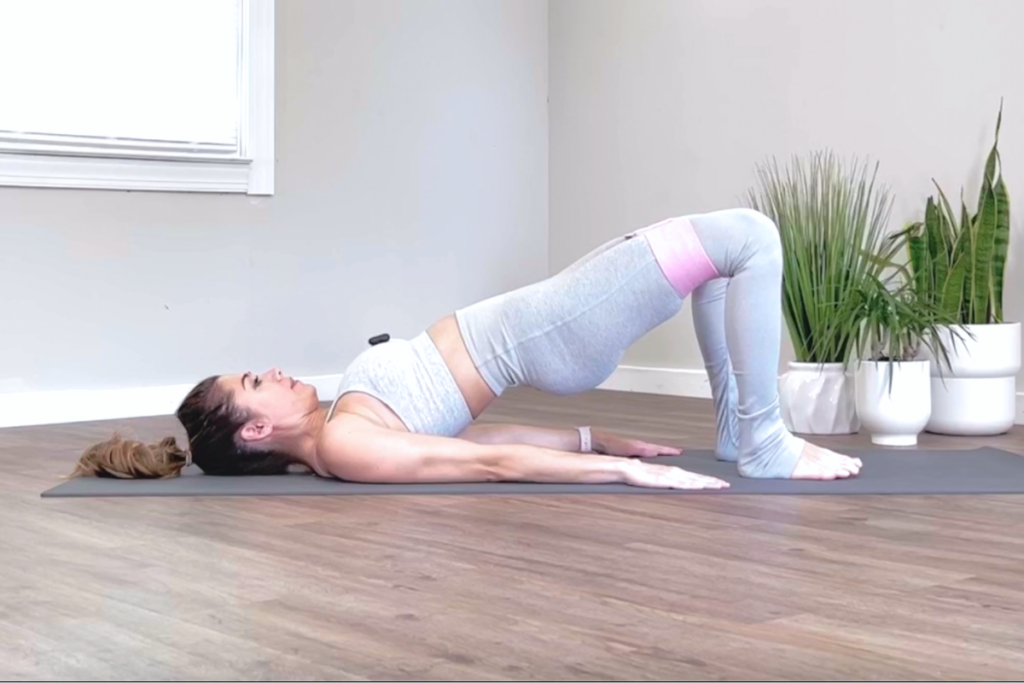
These muscles are responsible for hip abduction. You don’t have to have a resistance band, but grab one to add to your work out.
Grab a block, kids bouncy ball, rolled towel, or folded blanket. You can do this variation in low or high bridge, you can even do it without even lifting into bridge pose.
Socks, sliders, paper plates, or washcloths all work well for this exercise. Grab one for each foot:
Just like for the hams, grab one for each foot: socks, sliders, paper plates, or washcloths:
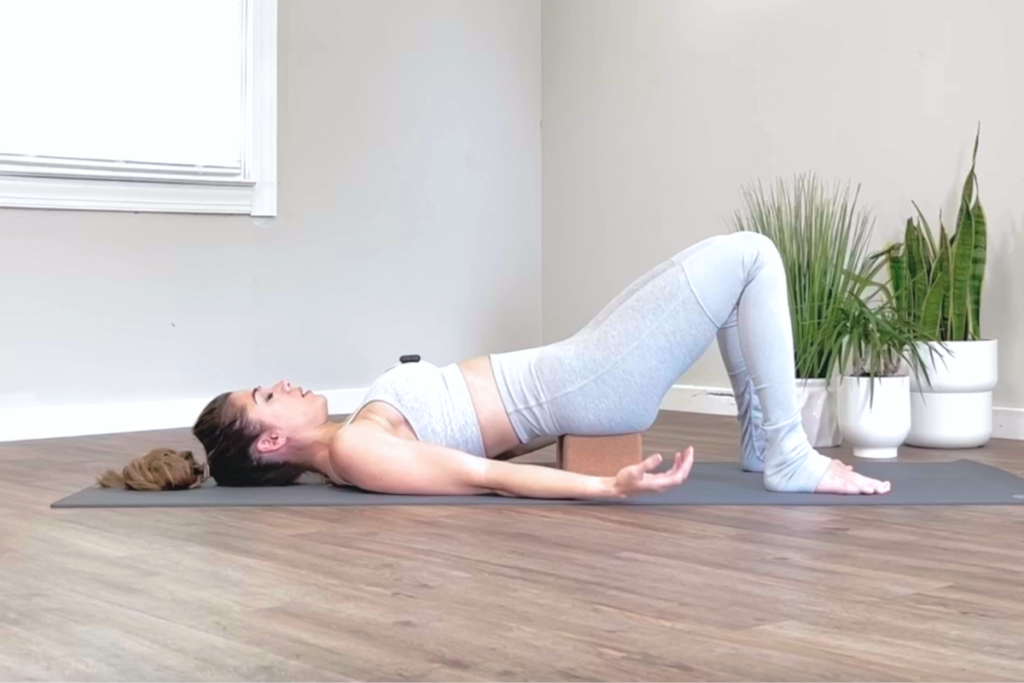
Inversions are often touted for their benefits (and there are many) but so many of them are inaccessible to many. But bridge pose, we can add a slight lift to the hips with props to get the benefits without requiring standing on our hands.
There are a few contraindications to bridge pose because it is an inversion. Talk to your doctor, physical therapist, or yoga therapist before doing bridge pose if you have any of the below conditions:
As I mentioned above most of these conditions bridge pose can be adapted to accommodate, but the guidance of a medical professional is advised before attempting this pose or starting any form of physical activity.
Did you know you could do all those things in bridge pose!? Even if you did, I hope it brought some inspiration to your practice. I encourage you to watch the video, if you haven’t already, and explore all the ways to move through bridge pose.
